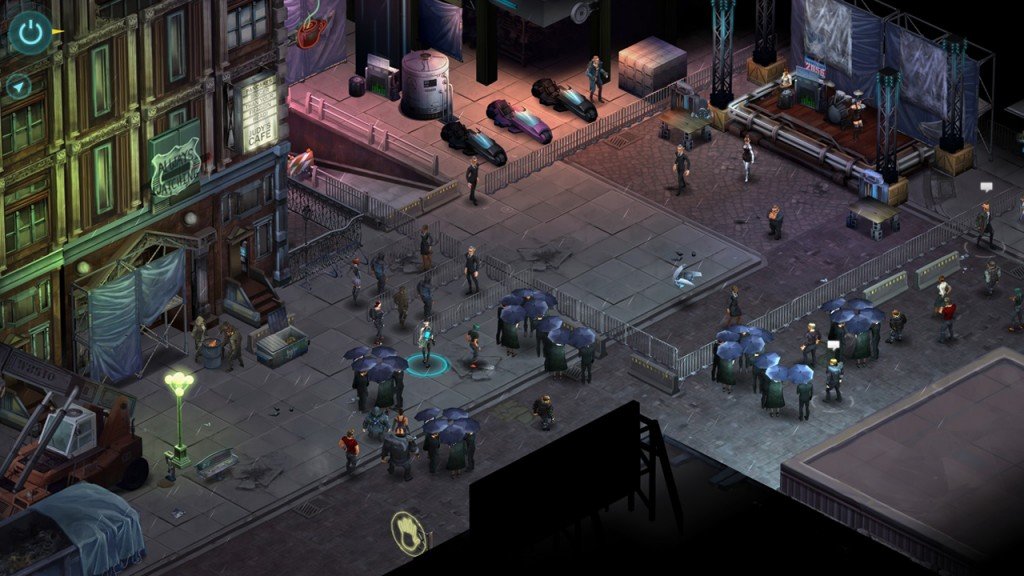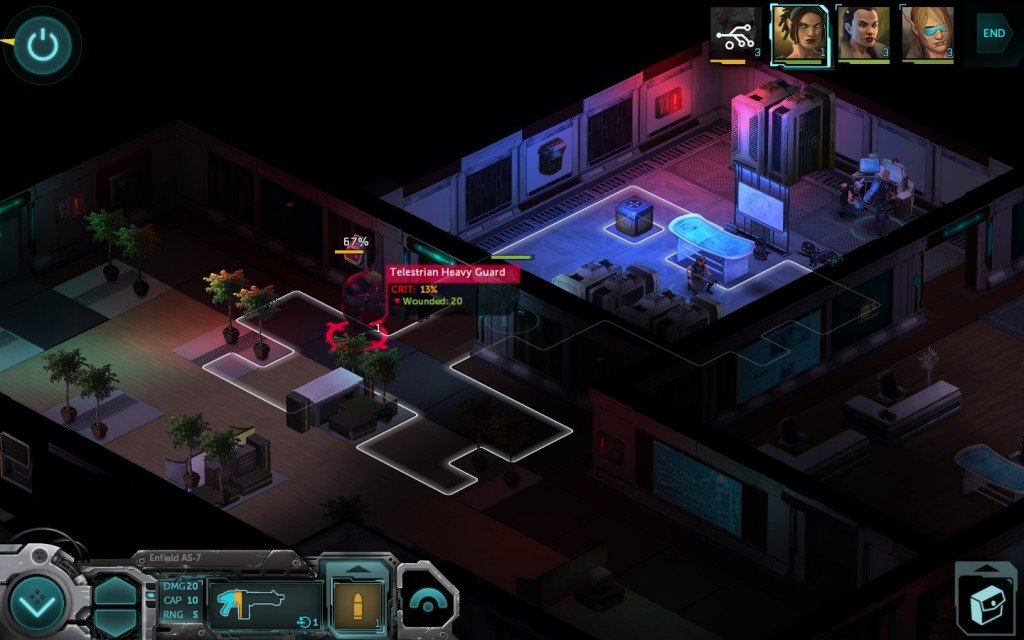Take a trip back to the mid 90s, back to what many would call the ‘golden days’ of RPGs. The genre saw an influx of isometric RPGs that stressed tactical and team-based combat. RPGs during the 90s also stressed unrelenting challenge, such as Baldur’s Gate, and if you lost a companion during combat, that was it. Just like that, companions were gone for good along with any story or dialog they brought to the game. But something happened in the early and mid 2000s, companies stopped putting gamers unders the harsh scrutiny of hard-core RPGs and instead opted for more open, easy-to-get-into titles that anyone could just pick up and play. However, there are plenty of people who aren’t satisfied with this direction and disappointed that the hardcore RPG genre has all but disintegrated. Enter Shadowrun Returns; a tactical, isometric RPG that stresses the aspects and strategic combat that you’ve come to appreciate of old school RPGs. From the healthy difficulty to the focus on character building, Shadowrun Returns may not be a “great” RPG but it shows that there are still developers out there willing to take risks and challenge anyone willing to embark on the journey.
In terms of quality, Shadowrun Returns is a roller coaster of variation. The art style is undoubtedly recognizable as indie but combines with an isometric, symmetrical grid-style reminiscent of games like the original Command and Conquer or RPGs like Planescape Torment. Although old-school isometric RPGs preferred a more gritty, realistic style of art, Shadowrun pulls of a cartoony, stylized look adequately. Although, given the grim setting of the game, a darker, more realistic art style would have suited the sprawling streets of Seattle much better. Unfortunately, misplaced art style isn’t the only issue surrounding the visual direction; the animations are, for lack of a better term, far below average, the walking animations are stiff and combat animations are equally so. This may, in part, be due to rendering animations through a 3D modelling program rather than using sprite art; regardless, the animation quality is noticeably under par despite best efforts to improve quality with a 3D engine.
What makes Shadowrun Returns a proverbial diamond in the rough? The tactical top-down combat uses an action point, turn-based system that allots the you certain number of action points (2-3 early on and increasing as you gain more skills), of which is spent on actions such as moving, attacking or using items. Throughout the game, certain enemies will have special attacks that will force you to think about each characters position on the field. Some enemies have attacks that drain action points, slow down targets or outright stuns their opponents for a certain amount of turns. In theory, this system works very well and makes you think before attacking or moving, but in practice, despite the ranged focus weapons such as pistols or rifles giving a unique take on an isometric RPG, the game play lacks a certain depth. The levels tend to be on the easier side with enemies that can simply be gunned down in one attack with a few tougher opponents peppered in randomly. Environmental hazards, traps or any type of danger outside the realm of combat would have added a much needed dimension to the overall combat experience. The game play looks great on paper but lacks any true depth or unique feature to set it apart from any other run-of-the-mill turn-based RPG.
Where this title truly shines, however, is the overall RPG elements. Starting with the the character creator, it is obvious that the developers wanted to create something special, beginning with the ability to play another race completely, a feature that is all too often reserved for MMOs only. Classes get a personalized treatment, starting with the ability to create a unique class, much like the Elder Scrolls games that came before Skyrim. If you don’t want to take the time to create a class of your own, however, there are plenty of default classes to pick from; the weapon-focused Street Samurai, tech savvy Deckers, Shaman and their magical minions, Drone-orientated Riggers, magic wielding Mages or you could just punch someone in the face as an Adept, the choice is yours so grab a rifle and start lobbing grenades.
The character creator just skims the surface of some of the ideas that the developers were trying to achieve. Rather than leveling up in a traditional manner, your character gains ‘Karma’ through varies tasks, this Karma is spent on skills that can be freely mixed and matched depending on what type of character you want to build. Don’t be mistaken, however, leveling up is not all about getting the next skill box so that new sword will hit for 5 instead of 4, there are plenty of auxiliary skills that do not necessarily pertain to combat, most notably the charisma skill. As it suggests, charisma allows certain NPCs to be manipulated through dialog which can lead to more credits, Karma or alternate methods of how situations play out. Much like the combat, however, these non-combat system lack any sort of depth. If characters could be recruited to fight rather than having to get your hands dirty personally, that would have given the charisma skill a tangible purpose that can progress you through the game rather than net you a few more credits. All too often, games will make a skill like Charisma more of a gimmick than a legitimate feature and will, more than likely, outright remove any such skill rather than fully fleshing it out. Shadowrun may not have given these kinds of skills their full potential but it is nice to see them try to make it function rather than cutting it completely.
Skills are also very closely tied with races in that certain races have a superior skill set than other. Elves, for instance, are more charismatic than other races and are given bonuses as such. Orcs and trolls are stronger and humans are quicker. Along with these bonuses is the outright limitation of how far a character can progress a given skill tree with elves being able to obtain the entire charisma skill set or trolls being able to invest completely into strength. While this may seen like a restriction, it is a good restriction in the sense that it adds another layer of immersion and difficulty when it comes to choosing which race to play.
At first glance, Shadowrun Returns seems like the perfect RPG for fans who want something a little more hardcore. But while it is certainly a good title, there are several issues that have held it back, most notably the lack of depth in several of the game play systems. As a sort of recurring theme in this article, lack of depth has been a persistent problem throughout this title. The weapons and armor lack depth by only offering simple stat boosts rather than attempting anything interesting or unique. The quests are terribly linear and usual consist of just clicking dialog icons until you fight an enemy and progress to the next part of the story, resulting in an incredible lack of replay value. The world itself is also linear, with most of the game sending you to a pub hideout and teleporting you to different levels. Overall, it feels more like a quest hub rather than an important plot location.
The story lines behind said quests also lack a certain quality. Without spoiling anything, there are no shortage of surprises at characters motives, which may sound positive, but many of the times it is because antagonists lack any logical motivation and often devolves into an evil character doing evil things because they are evil. Thankfully, the world itself is a different story with a broad spectrum of lore based on the table-top RPG that builds an interesting and diverse world full of elves dwarves and. . . Chicago. It may sound like a strange world that pushes beyond the boarders of standard fantasy, but the presentation of this world as a modern-day, grim urban setting with fantasy elements is something truly unique.
Ironically, the harshest criticism of Shadowrun Returns may also be a compliment; it deserved a AAA budget. Throughout the game, there are signs and subtleties that the developers truly wanted to create something special. They wanted 3D quality art, but lacked the resources to do it efficiently, they wanted broad dialog options, tactical combat and an impressive world that you could get lost in but simply did not have the means to do so. If Shadowrun Returns was ever made into a proper AAA series with a development team with the same level of passion that this game had, it could easily be a contender for the best RPG in recent years.
If you have been yearning for more classic style RPGs or just want to try one with a different setting that goes outside of what you know about fantasy, Shadowrun Returns is unquestionably worth looking into.
This review is based on a review copy of the Steam version of Shadowrun Returns developed by Harebrained Schemes
- Classic RPG Feel
- Challenging Combat
- Lack of Depth
- Too Ambitious



